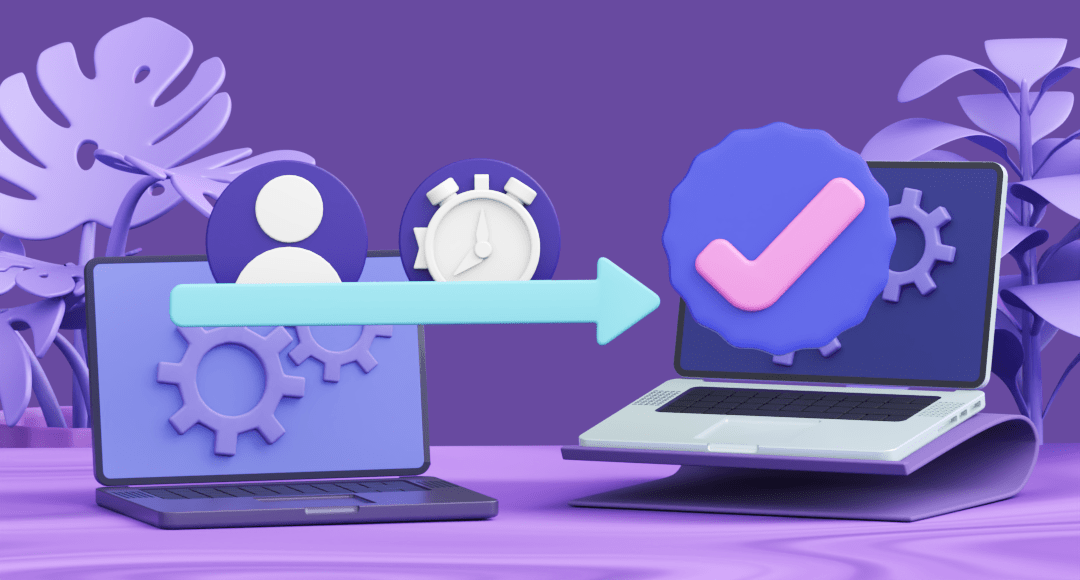What is Critical Chain Project Management (CCPM)?
Critical chain project management (CCPM) is a project management methodology that helps project managers identify both task and resource dependencies to ensure successful project completion.
CCPM can be thought of as a response to the critical path method (CPM) — a project scheduling algorithm that effectively calculates project deadlines based on task duration, but treats every other project resource as if it were infinite.
Unlike CPM, CCPM considers finite resources such as people, equipment, and physical space as the key project constraints.
In our guide to critical chain project management, we’ll explain:
- The critical chain and its components,
- The difference between CCPM and CPM,
- How to manage projects using CCPM, and
- The advantages and disadvantages of CCPM.
We’ll also include an example of CCPM so that you get a better understanding of how you could apply this approach to your future projects.
Let’s start!
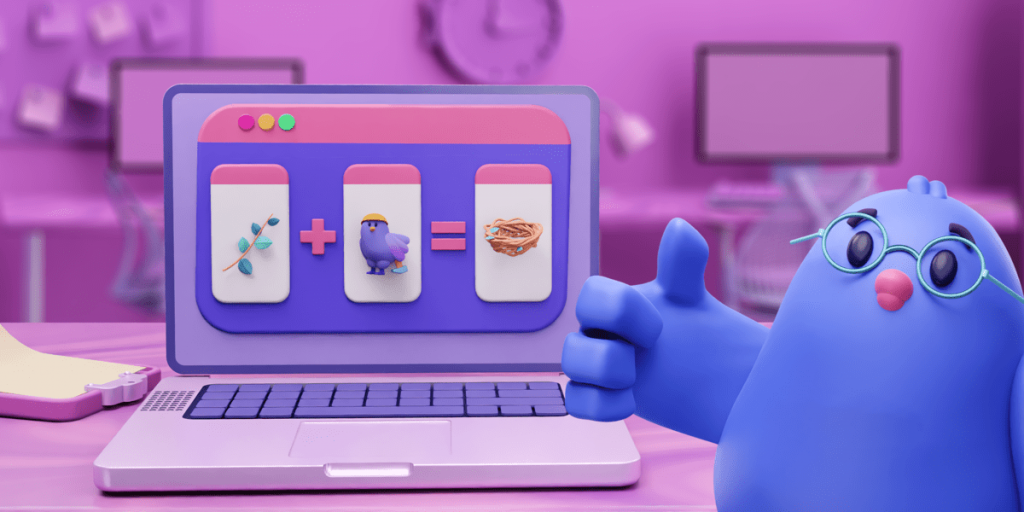
Table of Contents
What is the critical chain in project management?
The critical chain is the longest sequence of tasks in a project once the schedule has been leveled for resources.
The idea of a critical chain originated in 1997 in the business novel Critical Chain written by Eliyahu M. Goldratt, an Israeli business management guru.
The critical chain method is derived from Goldratt’s Theory of Constraints (TOC). Goldratt introduced this theory in another business novel way back in 1984.
Since the main focus of CCPM are task dependencies and resource constraints, the critical chain is also a sequence of resource-dependent tasks that incorporates time buffers throughout the project.
In general, CCPM may be more suitable for complex projects that involve various constraints and dependencies. As it takes into account so many uncertainties, its use of buffers should essentially cushion the blow of any changes and ensure the project gets completed on time.
Most notably, CCPM deals with the following issues we can often encounter in project management:
- Parkinson’s law,
- Student syndrome, and
- Multitasking.
Issue #1: Parkinson’s law
Coined by naval historian C. Northcote Parkinson in 1955, Parkinson’s law states that “…work expands so as to fill the time available for its completion”.
When we consider this from a project management perspective, it means the project team will take longer to finish their tasks if they are given a lengthier deadline.
Knowing they have plenty of time, they will procrastinate and finish the tasks just before the end date. Alternatively, they’ll just take their sweet time doing the tasks to fill the allocated time.
Sometimes, the team might also resort to gold plating — adding extra features outside of the agreed-on project scope — because they have extra time on their hands and would like to perhaps impress the client. But gold plating can be rather harmful to the whole project’s performance, as it can ultimately:
- Cause delays,
- Make the project cost more, and
- Upset the client.
Issue #2: Student syndrome
The student syndrome is also known as planned procrastination, and it entails starting a task as late as possible. This induces a level of urgency that spurs a person into action to get the task done on time.
The syndrome got its name from students because they often resort to this kind of procrastination. It was introduced by Goldratt in his book on the critical chain method as one of the mechanisms that waste a project’s safety.
Issue #3: Multitasking
In his book, Goldratt also mentions multitasking as “probably the biggest killer of lead time”. As the term says, this involves doing multiple tasks at the same time.
The fast-paced world we live in has given way to multitasking and proclaimed it as one of the best ways to increase productivity. However, a study showed only 2.5% of people can multitask properly — while others actually decrease their performance due to doing more than one task at a time.
Neuropsychologist Cynthia Kubu, Ph.D. has also said that people are wired to be monotaskers. In an article for Cleveland Clinic, she explained most of us aren’t multitasking at all:
“When we think we’re multitasking, most often we aren’t really doing two things at once. But instead, we’re doing individual actions in rapid succession, or task-switching.”
What are the components of a critical chain?
The critical chain consists of 3 main parts:
- The critical chain,
- The feeding chain, and
- The buffers.
Let’s go through each of these in more detail.
Critical chain
As mentioned, the critical chain represents the longest string of tasks in the project schedule that takes into account task dependencies and resource constraints.
In contrast, the critical path is the longest sequence of dependent tasks in a project whose only constraint is time.
When we want to implement the critical chain method in project management, one of the major steps is critical path analysis.
The critical path can serve as the starting point for critical chain project management. It shows us what the ideal task sequencing would look like if time were the only constraint and all other resources were unlimited.
With task durations as the only project constraint, we can use CPM to calculate the optimal critical path. However, the goal of CCPM is not to find the most optimal critical chain — but one that’s good enough to see the project through.
Once you level the resources — adjust the schedule to take constraints other than time into considerations — the critical path transforms into the critical chain.
Feeding chain
The feeding chain is a non-critical chain — an additional chain of dependent tasks that runs alongside the critical path. It consists of tasks that must happen at the same time as the tasks on the critical chain so that the critical chain doesn’t experience any delays.
The tasks on the feeding chain don’t affect the critical path, but you still have to finish them on time to complete the project. So, this chain has its own buffer — feeding buffer — that ensures the task sequence is finished on time.
You can schedule tasks on the feeding chain as early or as late as possible, depending on what your circumstances are.
For example, if there’s lots of uncertainty or the tasks will cost a lot, it might make sense to schedule them as late as possible.
However, if you’re not actually getting paid for the project unless you’re doing something tangible, i.e., bringing earned value, scheduling them as early as possible might be a better option.
Either way, the critical path and feeding chain are mainly conditioned by resource availability. This ultimately determines the task schedule.
Buffers
We use buffers as safety measures in critical chain project management. Their purpose is to ensure the project’s success by protecting the project timeline and deadline in case something goes wrong.
According to a paper on resource buffers in CCPM, the most common buffer types in critical chain project management in a single-project environment are:
- Project buffer,
- Feeding buffer, and
- Resource buffer.
Project buffer
A project buffer is an explicit, pooled time buffer that’s added at the end of the project to preserve the project’s duration. This buffer makes sure the project ends at the date you communicated to the key project stakeholders.
Feeding buffer
A feeding buffer goes between the feeding chain and the critical chain and prevents any disruptions from affecting the feeding chain. At the same time, it safeguards the critical chain from delays that may come up due to problems on the feeding chain.
The key part to remember here is that you don’t add a feeding buffer after each individual activity on the feeding chain.
Instead, you include it after the last activity — before the feeding chain merges with the critical chain. This gives the project team enough time to tie up any loose ends.
Resource buffer
Resource buffers refer to critical resources — such as people, space, and equipment — that are necessary for project completion. This makes them rather different from the other 2 types of buffers, as they don’t necessarily cost more money or take up more time in the project network.
Project managers distribute resource buffers throughout the critical chain to ensure appropriate resources availability for each task. They act as a warning signal — a wake-up call — for the critical resources so that they make themselves available in time for the upcoming task.
Effectively, resource buffers protect the critical chain from potential resource unavailability.
Another type of resource buffer you could use in CCPM is a capacity constraint buffer.
In his book on critical chain project management, Lawrence P. Leach describes the capacity constraint resource as “the resource that is most often overloaded”. This sort of constraint is common in multi-project environments, so a dedicated buffer is added between individual project schedules to ensure the resource is available for its scheduled use.
Such a buffer could also be used within a single project, but it’s a rarity. The buffer would add to the expenses, which would likely go against any organization’s cost management principles.
The difference between the critical chain and the critical path
The main difference between the critical path method and critical chain project management is their focus. While CPM emphasizes task durations, CCPM highlights efficient resource allocation.
Another difference is in the extra time you get with each method.
In CPM, you calculate project float — the extra time you can dedicate to tasks without jeopardizing the project schedule.
In CCPM, however, you intentionally add buffers as contingencies to prevent schedule disruptions and allow for more flexibility for the entire project, non-critical activities as a whole, or resources.
Here are some other ways CPM and CCPM differ:
| Critical path method (CPM) | Critical chain project management (CCPM) |
|---|---|
| Static method | Dynamic method |
| Focuses on task management | Focuses on resource and buffer management |
| Emphasizes each assignment | Emphasizes the end goal |
| Assumes all resources are infinite | Knows resources have limited availability |
| Zero float (extra time) for the activities on the critical path | Activities on the critical chain can make use of the project buffer |
| If a task is finished early, there’s a delay until the early start of the next task | If a task is finished early, you can move onto the next task right away |
| Individuals can be assigned to complete multiple tasks at the same time | Multitasking is prohibited, with individuals focusing on a single task at a time |
| Focuses on early and late start and finish dates | Focuses on fast delivery and only 1 start and end date |
| If an activity on the critical path requires more time, delays are inevitable | Real-time monitoring and buffer allocation encourage the timely completion of critical chain activities |
The expert we talked to, Jan Schiller, Partner and Chief Project Officer at Berkshire Consulting LLC, actually defines CCPM as CPM + resource management. As a regular user of CCPM, she explained:

“[…] launching a project without understanding the project’s resource demands in the context of the organization’s resource capacity and capabilities is a certain sign of struggling with success. A project manager should consider all elements that constrain a project; schedule (critical path) and resources (CCPM) are just two of the biggest constraints (both of which influence project cost relative to budget). I have contributed to the success of many organizations by applying CCPM because the organization is doing just that: launching projects without resource context.”
💡 Plaky Pro Tip
To learn more about the critical path method, check out the following guide:
How to manage projects with CCPM in 5 steps
The following 5 steps are the most basic ones you need to follow to effectively manage projects using CCPM:
- Find the critical path,
- Make aggressive estimates,
- Level the resources,
- Implement buffers, and
- Focus on the critical chain and monitor progress.
Step #1: Find the critical path
Since you can think of CCPM as an extension of CPM, it should come as no surprise that calculating the critical path is the first step in using critical chain project management.
While critical paths rarely coincide with critical chains in practice, we can still use them as a functional starting point for finding critical chains.
After all, it’s easier to take an existing framework and correct it for limited resource availability than it is to create a critical chain from scratch.
To find the critical path, you need to:
- Create a project work breakdown structure (WBS),
- Create a CPM diagram,
- Perform the forward pass (used to calculate the early start and early finish values for each project task), and
- Perform the backward pass (used to calculate the late start, late finish, and total float for each project task).
When making the diagram, take into account task dependencies. These will show which tasks depend on the completion of other tasks and help you determine their order in the project.
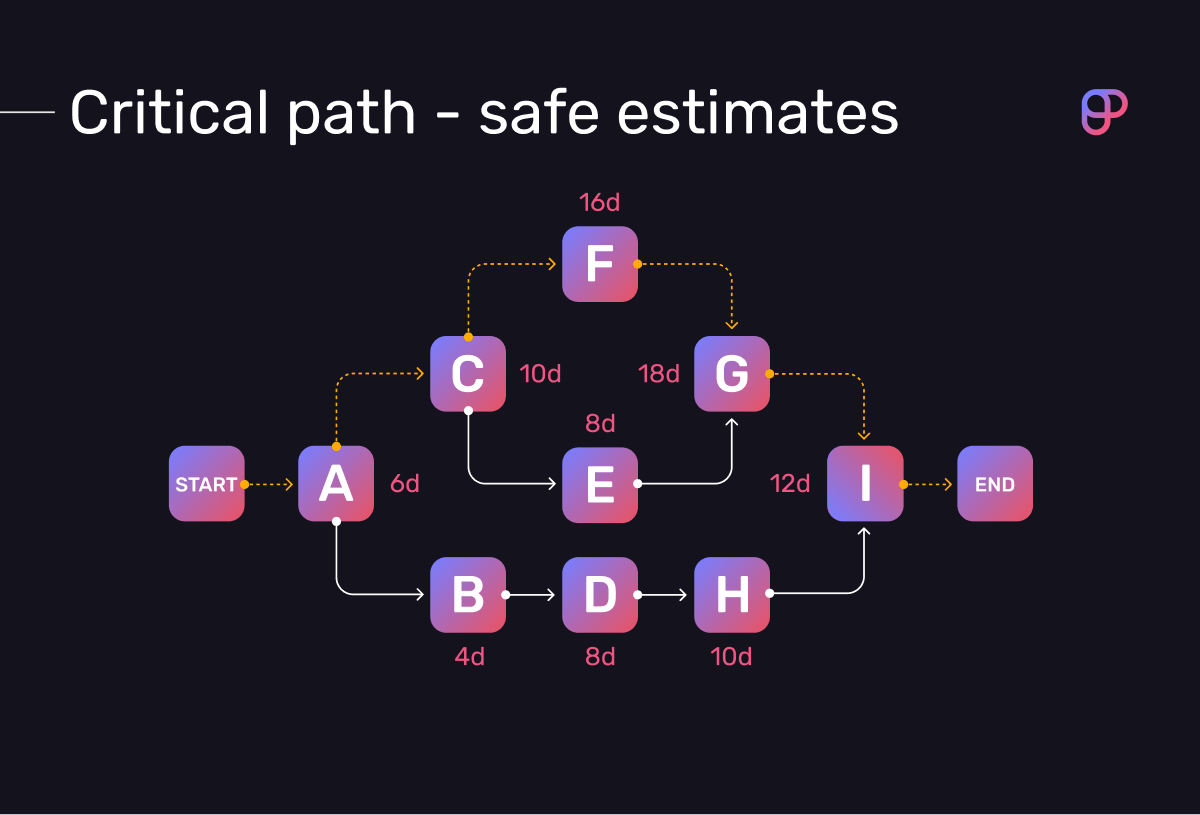
💡 Plaky Pro Tip
For further reading on WBS and all it entails, check out the guide below:
Step #2: Make aggressive estimates
CCPM uses a 2-point estimate system and distinguishes between 2 types of estimates: safe and aggressive.
Safe estimates are the subjective assessments of the project team — task durations they can comfortably commit to.
These guesses inherently have a safety cushion to them that may unnecessarily prolong the project or give way to Parkinson’s law and student syndrome.
Aggressive estimates are, in contrast, much riskier but potentially achievable target durations.
Goldratt suggests using 50% of the safe estimates as task durations throughout the project. So, we get these estimates by cutting each estimated task sequence (both critical and non-critical) by 50%.
Essentially, aggressive estimates are estimates we make with 50% confidence in their completion.
CCPM uses aggressive estimates because they increase urgency and potentially improve efficiency. They’re one of the lines of defense in CCPM against student syndrome and Parkinson’s law.
One thing to keep in mind here is that CCPM favors backward planning. So, when estimating task duration, start with the target end date. This way, you will know how late you can start the project but still meet the target end date.
Once you have the critical path and the aggressive estimates, you can assign resources to each task to know how many and which types of resources you’ll need to see the project through to the end.
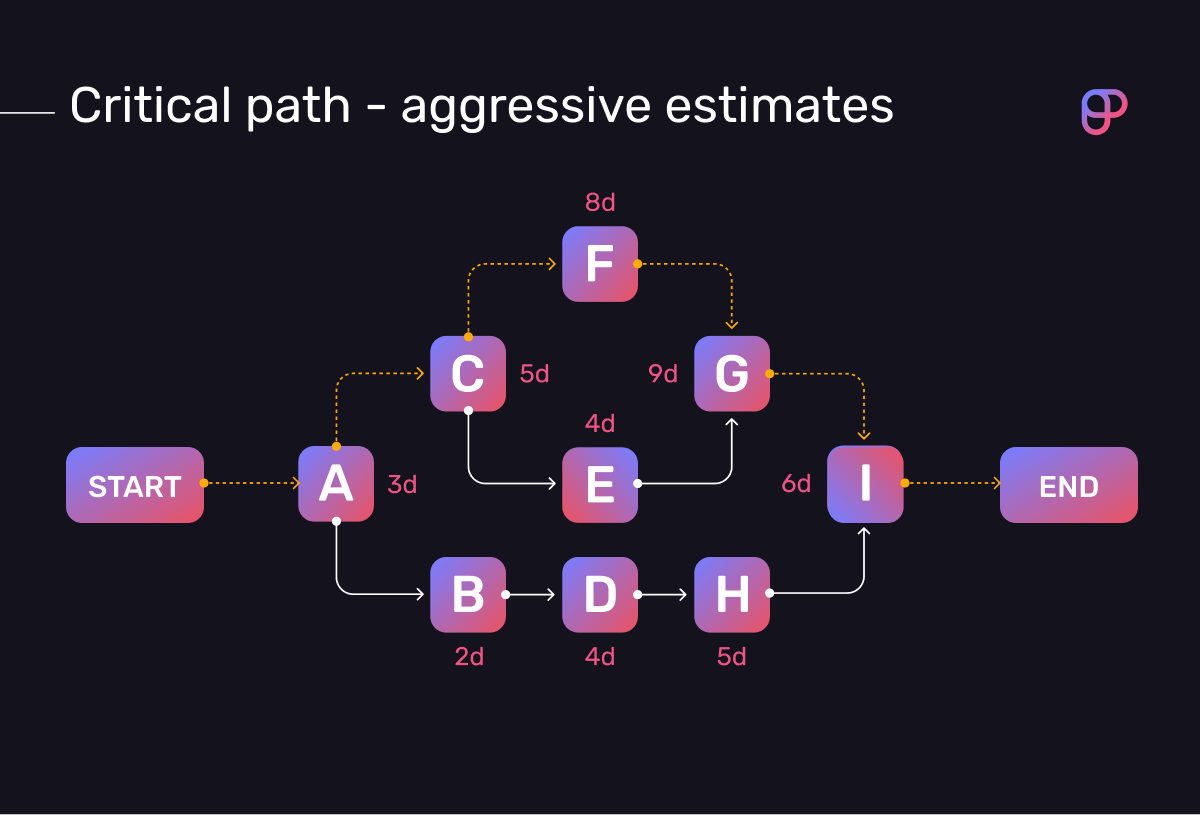
As you can see from the diagram, the critical path is now 31 days long, and there are 2 non-critical paths:
- Path B–D–H, which is 11 days long, and
- Path C–E–G, which is 4 days long.
Let’s see if all that changes when we level the resources.
Step #3: Level the resources
Resource leveling is the process of resolving scheduling conflicts linked to the use of specific resources throughout the project.
An example of this would be a key employee going on vacation in the middle of the project, or the need to use the same machine for 2 parallel activities.
By leveling resources, the project manager ensures the team can complete the project with available resources and without suffering any delays. Keep in mind this is likely to entail resequencing the project tasks to resolve resource contention and avoid multitasking.
According to Dr. Mike Clayton, there are quite a few ways to level resources:
- Postpone the project’s start date,
- Extend the project’s duration,
- Eliminate certain tasks from the project schedule,
- Split tasks up,
- Bring certain tasks forward,
- Allocate additional resources, or
- Find alternative resources (e.g., third-party contractors).
As shown in this paper on the integration of the critical chain method in the PMBOK guide, resource profiles can be used to help level resources in CCPM.
These are bar charts that show us project task organization in regard to time (x-axis) and a specific resource (y-axis). Leveling the resources entails putting a limit on the y-axis and rearranging the tasks so that they never go above it.
Don’t forget that you’re not looking for the optimal rearrangement of tasks, as such an arrangement would be either impossible or prohibitively difficult to find.
Instead, your goal is to find a good enough arrangement of tasks.
Substep #1: Level multiple resources at once
Since resource profiles only have 2 axes, you’d think you could only use them to level a single resource at a time.
However, a few simple tricks like using color and shading can help you identify resource overuse without occupying the y-axis.
For example, you can assign a color to each member and use it to color the visual representation of resource profile tasks they are assigned to.
This way, you can easily spot if the critical path schedule needs the same person to work on multiple tasks concurrently. You then use that information while rearranging tasks inside the resource profile.
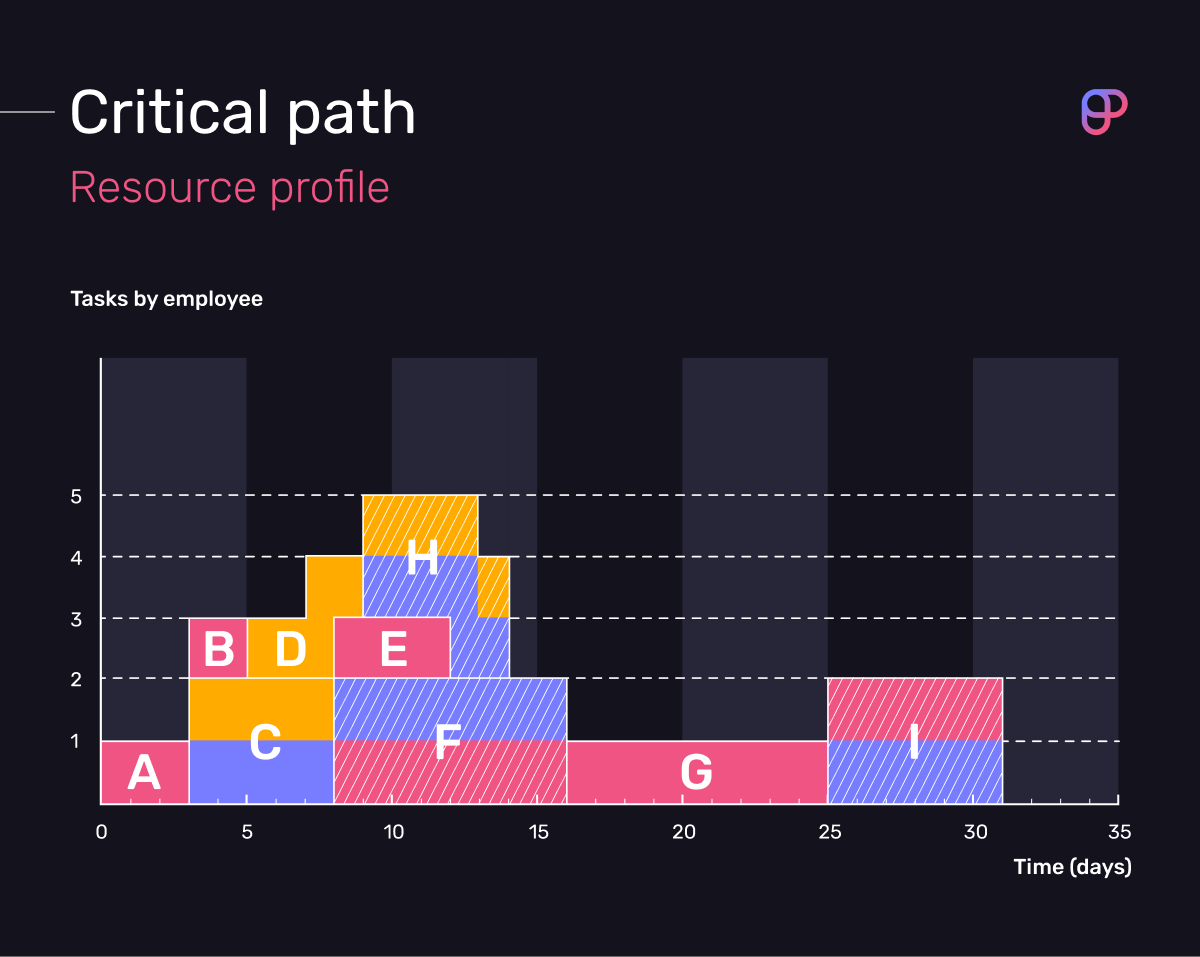
Ideally, no team member should be assigned to 2 or more tasks at the same time, as multitasking is shown to inhibit productivity.
Likewise, if you’re already using colors to mark task ownership but have to consider the use of physical space — let’s say a conference room — as another limited resource, you can use shading to distinguish the tasks that depend on the second resource.
This way, you can easily make sure no 2 tasks that require the use of the same conference room are scheduled at the same time.
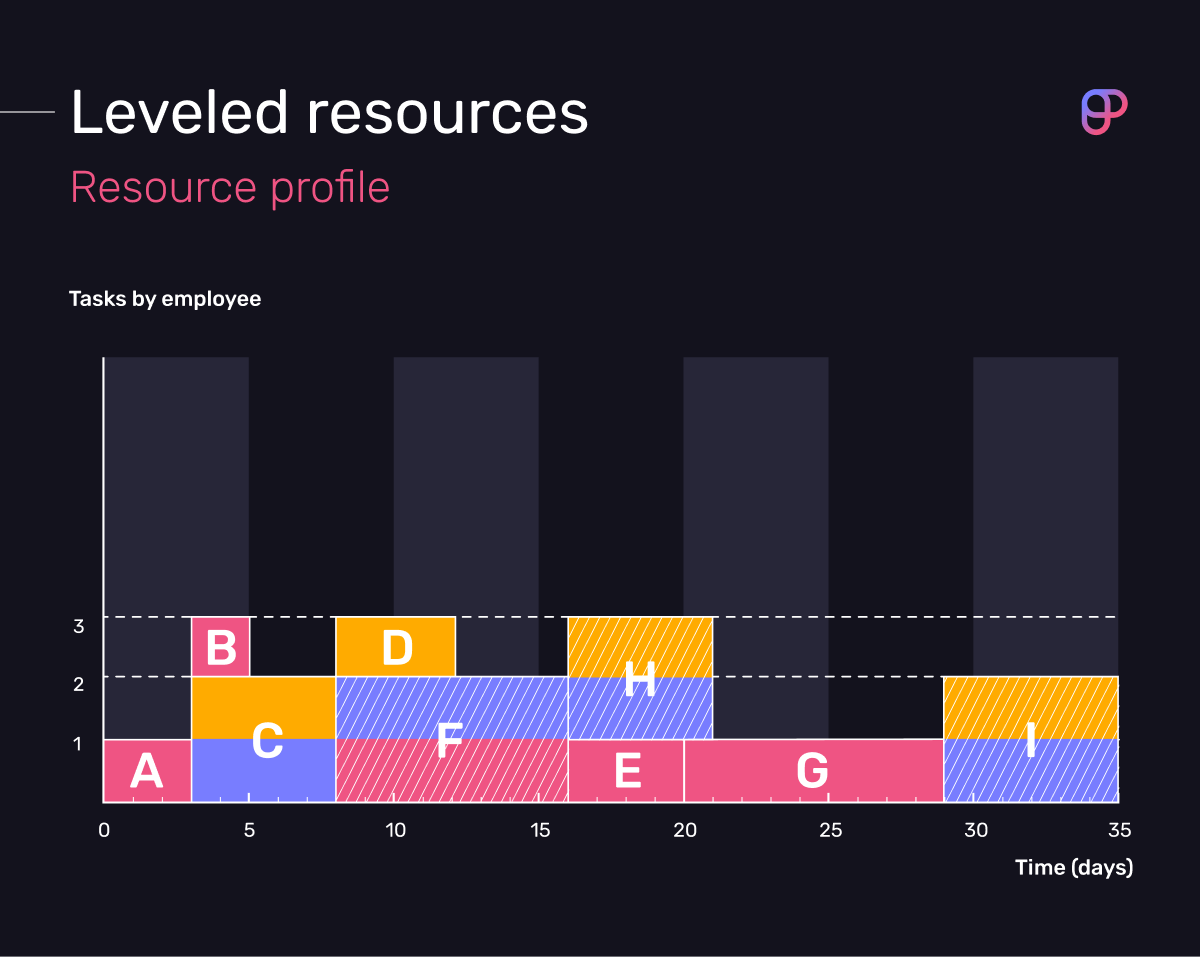
After leveling the resources, the length of the project changed as no other resources were available to add to it.
As you can see, CCPM views multitasking as the enemy. Luckily, you can also use project management software like Plaky to prevent this phenomenon. With Plaky, you get to assign tasks to team members and monitor who’s doing what task, all while ensuring no employee is assigned 2 or more tasks at the same time.
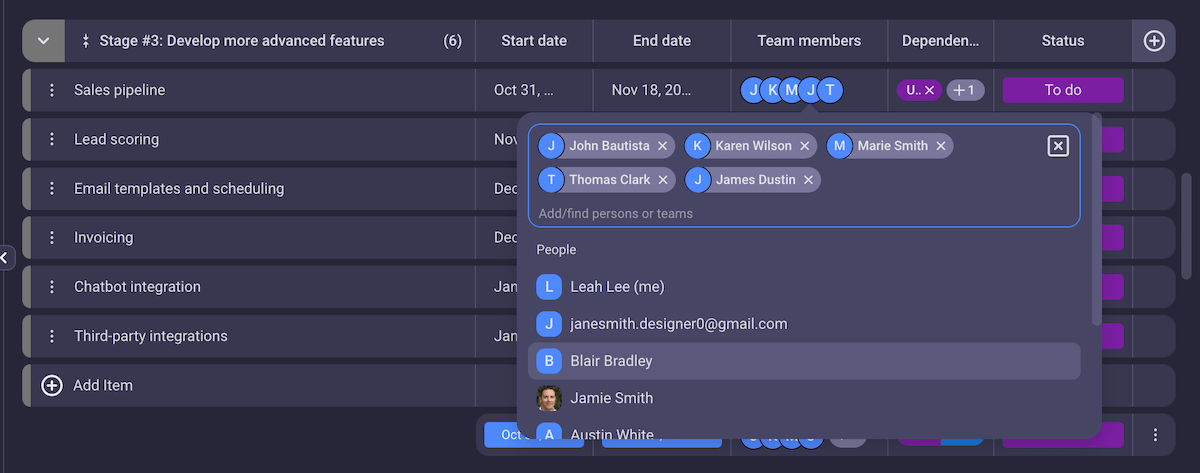
Once you’ve leveled the resources, you can make the project schedule and update the network diagram to see which tasks constitute the critical chain.
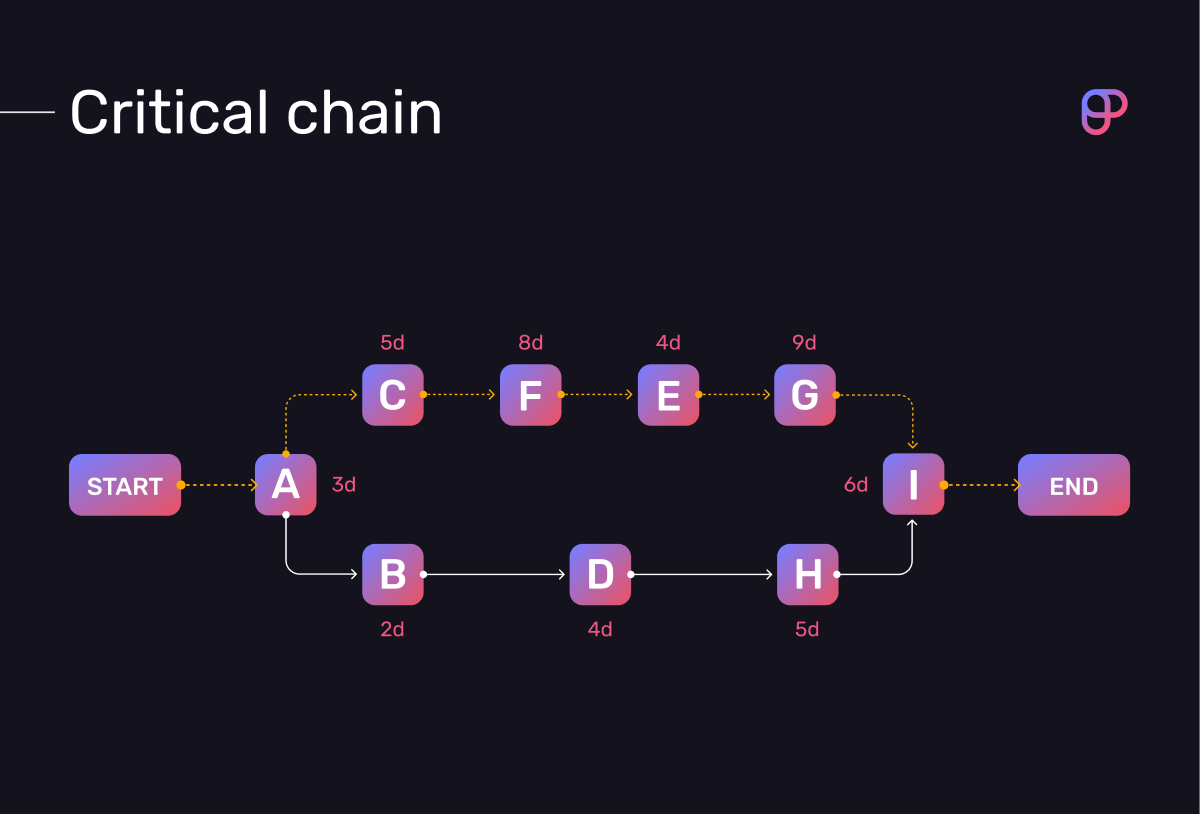
In the diagram above, the critical chain is the orange dotted line, and the non-critical chain is the plain white line.
According to the diagram, the activities on the critical chain (A–C–F–E–G–I) should take 35 days to complete. That’s 4 days longer than the previously calculated critical path due to a resource conflict.
Meanwhile, the tasks on the feeding chain (B–D–H) should take 11 days to complete.
Step #4: Implement buffers
We know how to find the critical chain now, but there’s more to CCPM than just making calculations.
Namely, this project management methodology also seeks to increase performance and measure progress. We achieve both of these goals simultaneously through the use of buffers.
As mentioned, buffers are the extra resources you leave on the side in case something goes wrong and delays project tasks.
Traditional project management still allocates extra time to each activity to ensure any difficulties encountered along the way don’t affect the project timeline.
For example, if a task is given an 8-day duration, the task can likely be completed within 4 or 5 days. The extra time is given to ensure unexpected wrinkles can still be ironed out without delaying subsequent tasks.
CCPM finds this approach suboptimal because of Parkinson’s law. According to that law, if a task was assigned an 8-day duration, it would take 8 days to complete, even if it could have been completed faster on a shorter deadline and without sacrificing quality.
The use of buffers (especially the project buffer) in CCPM serves the purpose of increasing performance by preventing Parkinson’s law and student syndrome.
The most common way to size buffers in CCPM is to use Goldratt’s proposed Cut-and-Paste method, which is based on using 50% of the safe estimate as task sequence duration.
This method is the easiest to implement because you just have to calculate 50% of the estimated duration and add it as a project or feeding buffer at the end of the related sequence.
Substep #1: Add the project buffer
The project buffer is the most important buffer in CCPM, as it shows you how much extra time you have to complete the tasks inside the critical chain.
To find out what your project buffer is, calculate 50% of the estimated project duration.
Let’s take the example from above. We’ve calculated that the critical chain should take 35 days to complete.
The project buffer is, therefore, 17.5 days — 50% of that estimate.
While CCPM generally tries to increase productivity by shortening task durations, this buffer should help ensure the team doesn’t miss the project deadline. When a task inside the critical chain takes longer to complete, you detract the extension from the project buffer.
After adding the buffer we calculated above, the new project duration estimate is 52.5 days.
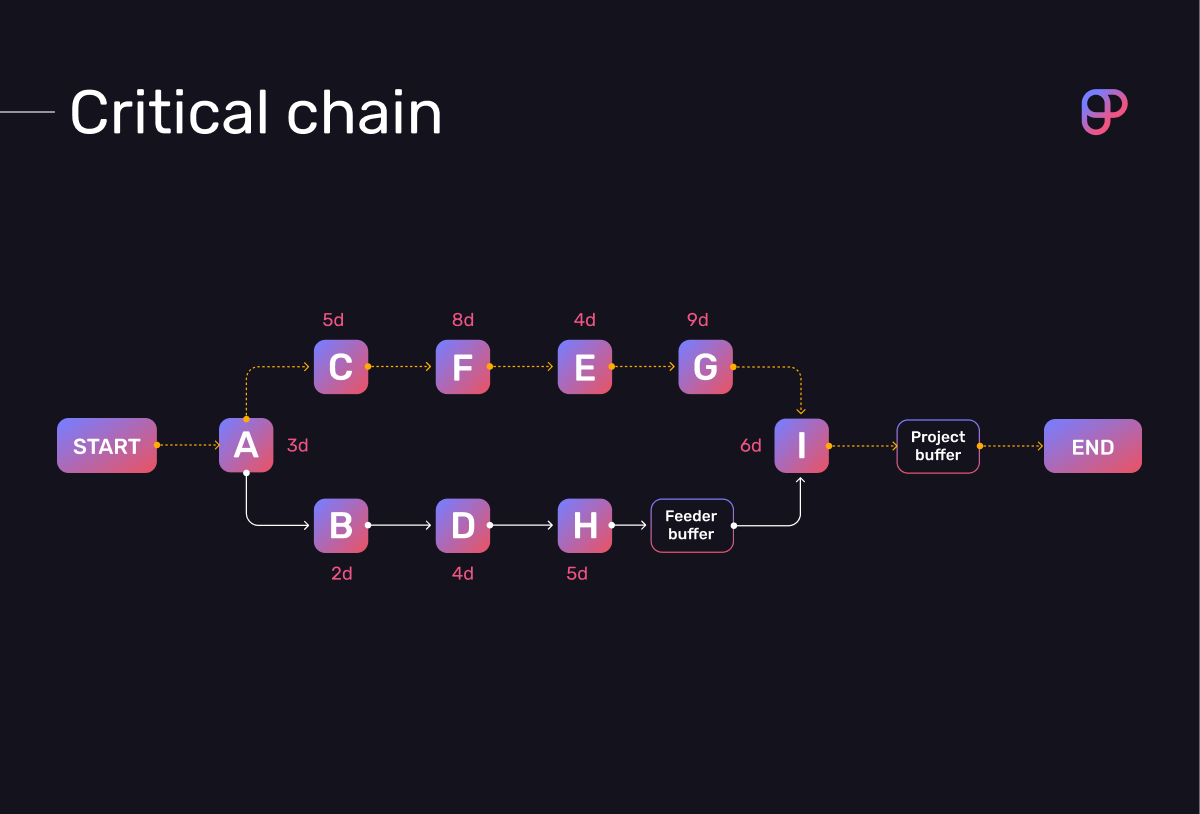
Substep #2: Add feeding buffers
Feeding (or feeder) buffers provide you with a bit more time to complete task sequences that aren’t on the critical chain.
The use of feeding buffers does not affect your total project buffer. Feeder buffers cannot be part of the critical chain. They can only feed into it, hence the name. However, if adding a feeder buffer would result in creating a new critical chain, make the feeder buffer shorter.
The feeding buffer is also 50% of the aggressive duration estimate of the relevant task sequence.
So, if we go back to the example from above, the feeding buffer for the non-critical chain should be 50% of the sequence’s duration (11 days) — 5.5 days.
Keep in mind that the Cut-and-Paste method doesn’t take into account inherent risk of the project activities. Thus, multiple buffer sizing alternatives have been suggested over the years that enable a higher level of accuracy, such as the:
- Root square error method,
- Adaptive procedure with resource tightness, and
- Adaptive procedure with density.
Substep #3: Add resource buffers
Resource buffers are placed within the critical chain to ensure critical activities have all the resources (time, equipment, etc.) they need. So, at this stage, you’d insert them in the network diagram wherever they are needed before a related activity starts.
Step #5: Focus on the critical chain and monitor progress
By performing steps 1–4, you’ll be able to identify the critical chain. Technically, that’s enough to use CCPM.
However, none of this will function as intended unless you continuously monitor progress.
As the expert we talked to, Jan Schiller, puts it:

“Update the information in the work plan to keep the plan aligned with reality, which includes adding issue resolution tasks, triggered risk mitigations, and approved change request impacts as indicated.”
A key part of CCPM is proper buffer management. This includes keeping a close eye on the buffer burn rate.
Substep #1: Monitor buffer expenditure
The buffer burn rate is used to gauge how well the project is performing. You can calculate it using the following formula:
Buffer burn rate = % of buffer penetration / % of critical chain completion
Essentially, if the rate is less than 1, you’re on a good track to complete the project on time. If it’s more than 1, the project is late.
Let’s consider project buffer expenditure to paint a better picture.
Taking the above example, if a quarter way through the critical chain (25%), the writer has used only 10% of the project buffer, they are doing well and are on the path to meeting the deadline. The buffer burn rate in that case is:
BF = 10/25 = 0.4
However, if a quarter way through the project (25%), the writer has already expended 40% of the project buffer, you can take it as a sign that there is a problem and that they probably won’t meet the deadline — unless you figure out what the problem is and address it. The buffer rate there is:
BF = 40/25 = 1.6
For proper buffer management and project control, project managers also use a buffer fever chart.
This chart shows the percentage of the completed project against the percentage of buffer consumption.
The chart is color-coded, with each color carrying a different meaning:
- Green — the project is on schedule,
- Yellow — the project is at risk, and
- Red — the project is late.
The chart essentially tells the project manager if they should take steps to mitigate risks and resolve problems.
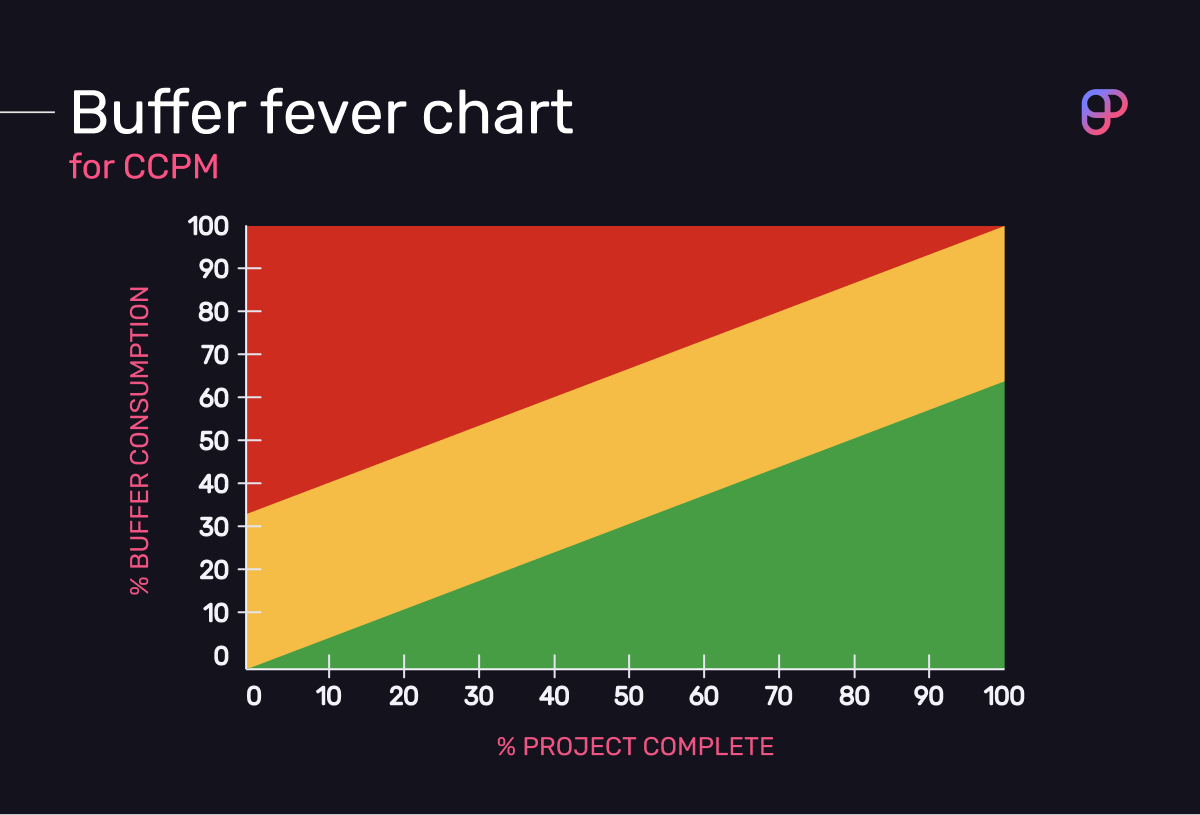
Substep #2: Create a distraction-free environment
You also must make sure the people working on the critical chain are free from distractions. The estimates are aggressive, and time is of the essence — so there’s no room for accidental or intentional procrastination.
The critical chain is often likened to a relay race — a team racing competition where multiple athletes stationed at different parts of the racecourse work in sequence to carry a baton across the finish line.
The comparison is apt, with team members acting as athletes and the baton acting as tasks within the critical chain.
In some CCPM teams, an actual baton — or some approximation — is passed off from person to person working on the critical chain. Seeing a team member with the baton should be taken as a sign not to disturb them with anything and to offer assistance if requested.
Virtual teams can also simulate this.
For example, if the project team is using a team communication tool, they can update their status using an agreed-on baton emoji (🏃). This emoji will be displayed next to their name and online status and act as the baton, similarly to how an icon of a hamburger shows when they’re on lunch break.
💡 Plaky Pro Tip
How important is team communication in project management anyway, and is there a way to improve it? Find out in the guide below:
Critical chain project management example
To further explain how CCPM is done, let’s look at a more detailed example. For the sake of clarity, we’ll take the process of writing an article as an example.
The goal is to finish the article on time so that the editors have enough time to check it before it is published. You are the content manager, so you assign this project to one of the writers in your team and start creating a critical chain plan.
Step #1: Find the critical path
The first step is to create a diagram that includes task dependencies and safe duration estimates. Here’s what the project task list looks like:
| Task designation | Task description | Safe estimate/ Duration |
|---|---|---|
| A | Conduct research | 3 days |
| B | Make an outline | 1 day |
| C | Look for expert sources | 5 days |
| D | Create the article cover and visuals | 5 days |
| E | Write the article | 12 days |
| F | Edit the article | 2 days |
| G | Send in expert quotes | 5 days |
| H | Send cover and visuals | 1 day |
| I | Add visuals and expert quotes | 1 day |
| J | Send article to the content manager | 1 day |
When looking at this work breakdown structure, it’s easy to spot that some things have to happen before the others, i.e., there are task dependencies you need to keep in mind.
For instance, the writer cannot do the article without creating the outline first. Likewise, they cannot add visuals to the article before they’re made, or add expert quotes without first talking to the experts.
You also have to take into account which activities have to run parallel to the critical path tasks. Those will become a part of the non-critical path.
Here’s how the critical path diagram looks based on the information above and before the resources are leveled:
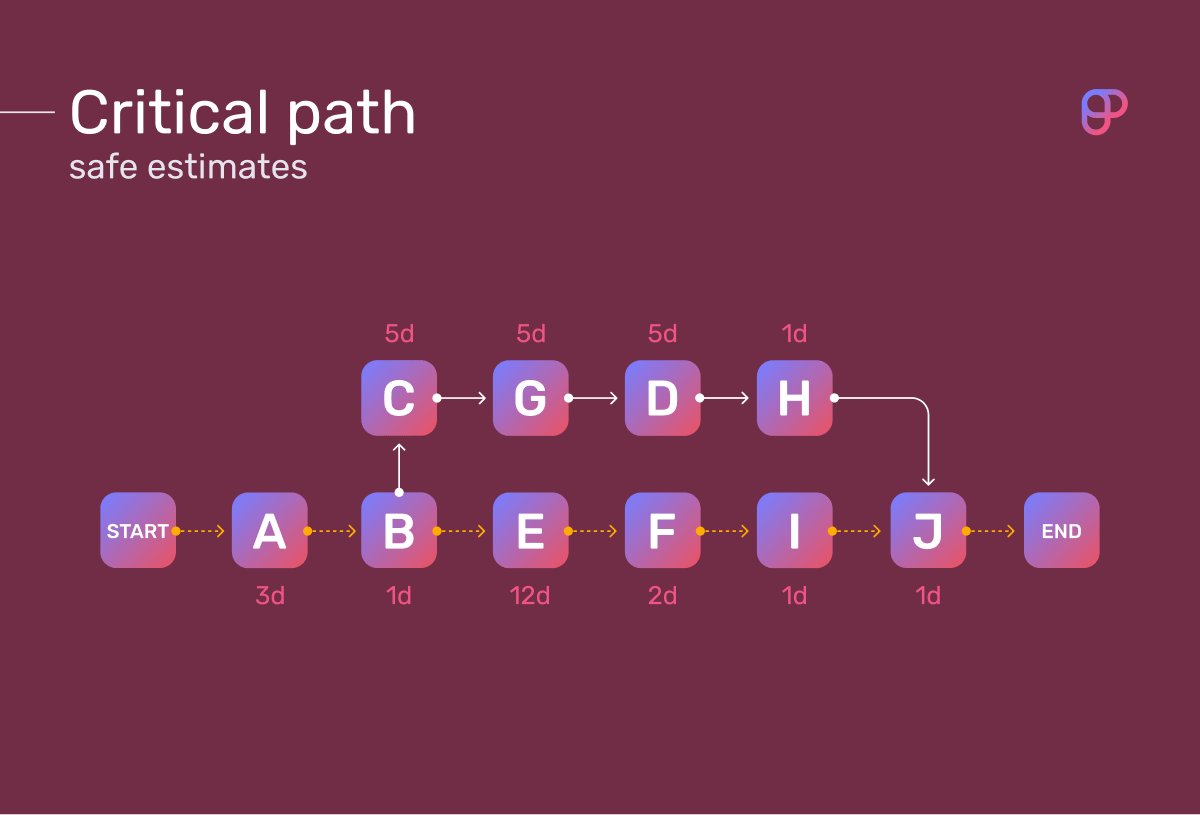
So, according to the diagram, the duration of the critical path is 20 days, and the non-critical path is 16 days long.
Step #2: Cut estimates by 50%
The calculated critical path based on safe estimates is 20 days. Now, it’s time to try to speed up project completion and make new, more aggressive target estimates.
When cut by 50%, this is how long each activity should last:
| Task designation | Task description | Aggressive estimate/ Duration | Resources |
|---|---|---|---|
| A | Conduct research | 1.5 days | Writer |
| B | Make an outline | 0.5 day | Writer |
| C | Look for expert sources | 2.5 days | PR |
| D | Create the article cover and visuals | 2.5 days | Design team |
| E | Write the article | 6 days | Writer |
| F | Edit the article | 1 day | Writer |
| G | Send in expert quotes | 2.5 days | PR |
| H | Send cover and visuals | 0.5 day | Design team |
| I | Add visuals and expert quotes | 0.5 day | Writer |
| J | Send article to the content manager | 0.5 day | Writer |
Now, the estimated duration of the critical path is 10 days, and the non-critical path’s duration is 8 days.
Sounds too ambitious because it is — but we’re not done yet. Things might still change because we have to take into account the resources, any conflicts that exist in regard to their allocation, and the buffers.
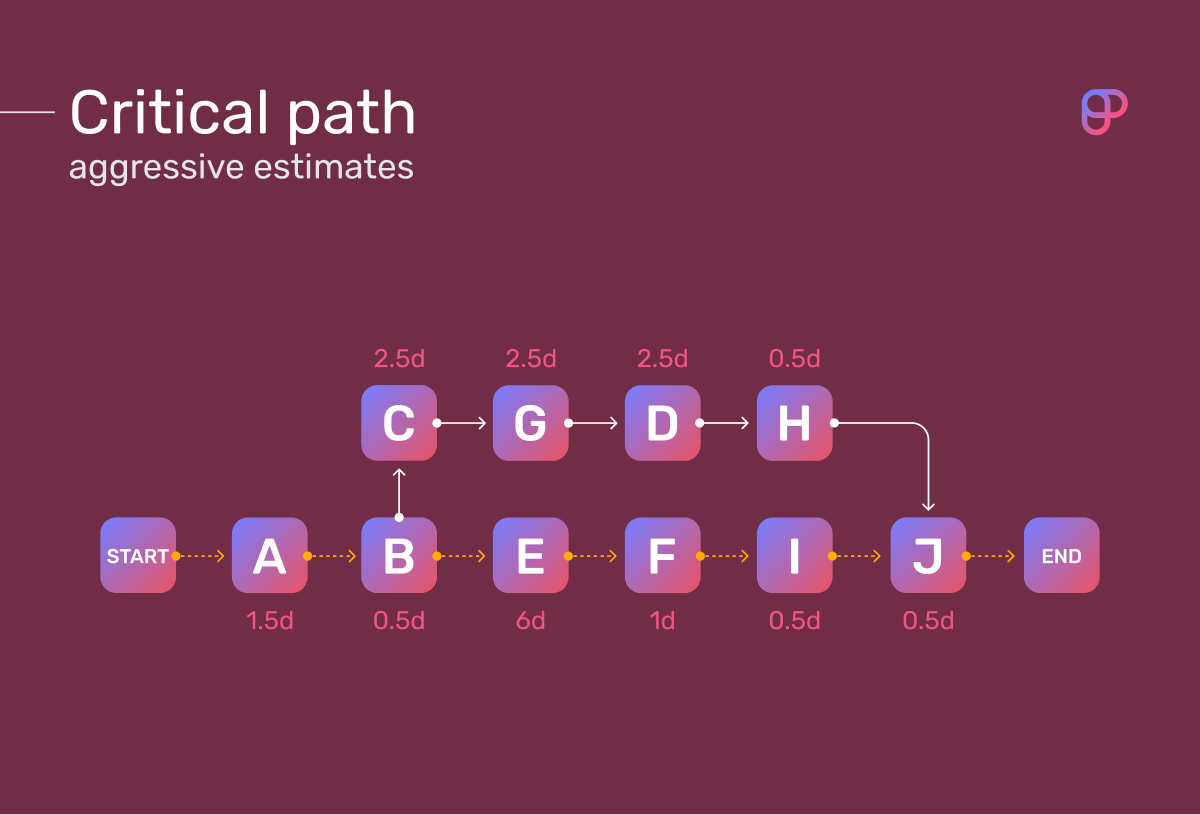
And speaking of resources, note that since multitasking is not allowed, certain activities have also been delegated to the PR and the design team. They will serve as additional resources for this project and should keep the deadline intact. But will they be available when you need them?
Step #3: Level resources
In the diagram above, we saw that the design team waits for the PR to deliver expert quotes to start their tasks. That’s not an efficient use of resources, especially when we have to take into account:
- The PR is going on vacation soon, so they’re available to do their tasks right after the writer does the outline,
- The design team is so busy that they can start making the cover and visuals once the article is already written, and
- The writer cannot send the article in without the quotes or the visuals.
So, after leveling the resources, the new diagram where we can positively identify the critical chain looks like this:
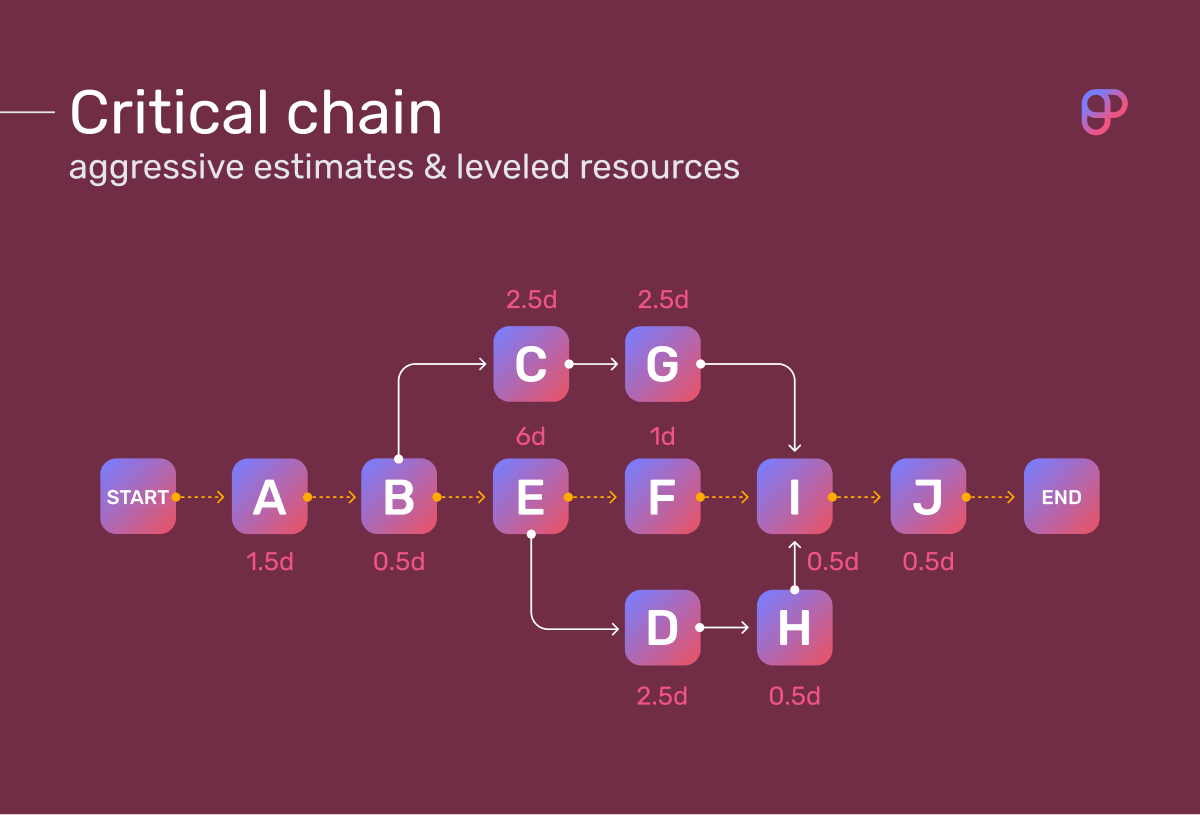
Based on this, you can see the critical chain is 10 days long. Meanwhile, the durations of the 2 feeding chains are 5 days (path C–G) and 3 days (path D–H).
Step #4: Add buffers
Now, it’s time to add project, feeding, and resource buffers.
The project buffer is the 50% of the estimated duration of the critical chain. As the critical chain is estimated at 10 days, the project buffer you can add at the end amounts to 5 days.
There are 2 feeding chains that need feeding buffers to ensure they don’t mess up the flow of the critical chain and delay the project. Here’s how you can add buffers there:
- Feeding buffer between tasks G and I — 50% of sequence duration = 2.5 days.
- Feeding buffer between tasks H and I — 50% of sequence duration = 1.5 days.
Finally, you have to add resource buffers. You can insert:
- A resource buffer for the PR between tasks B and C, and
- A resource buffer for the design team between tasks E and D.
Here’s how the updated critical chain diagram looks like:
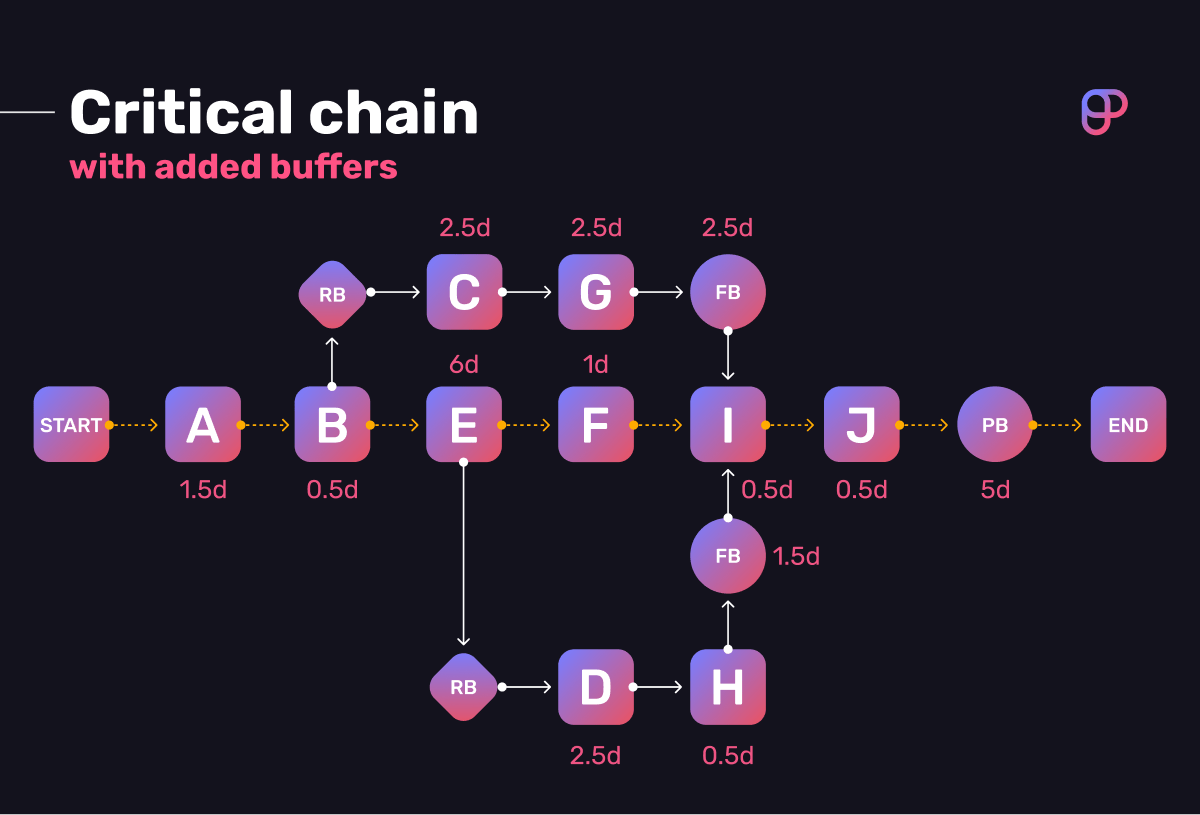
Step #5: Keep tabs on the progress
Now all that’s left is to keep track of the process. As the manager, you’re giving the writer lots of freedom as to the details of execution of the project. However, the steps you’ve outlined in the critical chain plan are a must — their order cannot change because the article won’t be done well or in time.
So now that you have the plan, what do you do?
Well, you monitor buffer expenditure. You need to know if and when the buffers are used and how that affects the whole project.
You should also be aware of when the next phase of the project is started. But there’s no need to ask the writer what they’re doing — you can keep tabs on that in task management software like Plaky via the Status and Date fields.
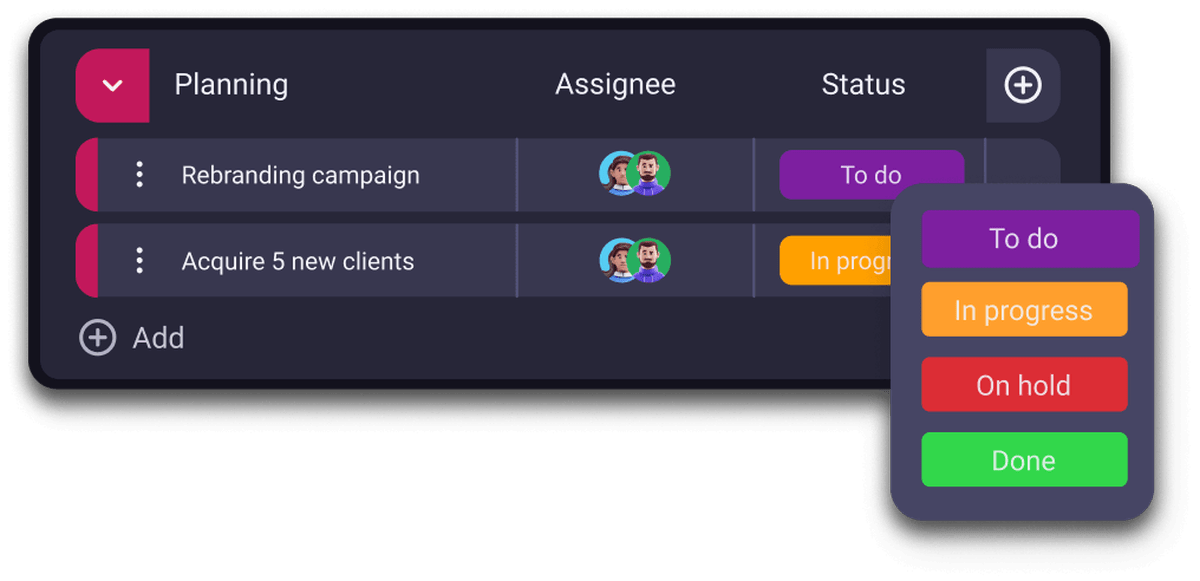
Additionally, you can make note of all the changes made for every activity in a Plaky board, including the date and time, task assignee, etc. in the activity log. That way, you stay in the know regarding the project’s progress, but you’re not micromanaging — if anything, you’re just a keen observer.
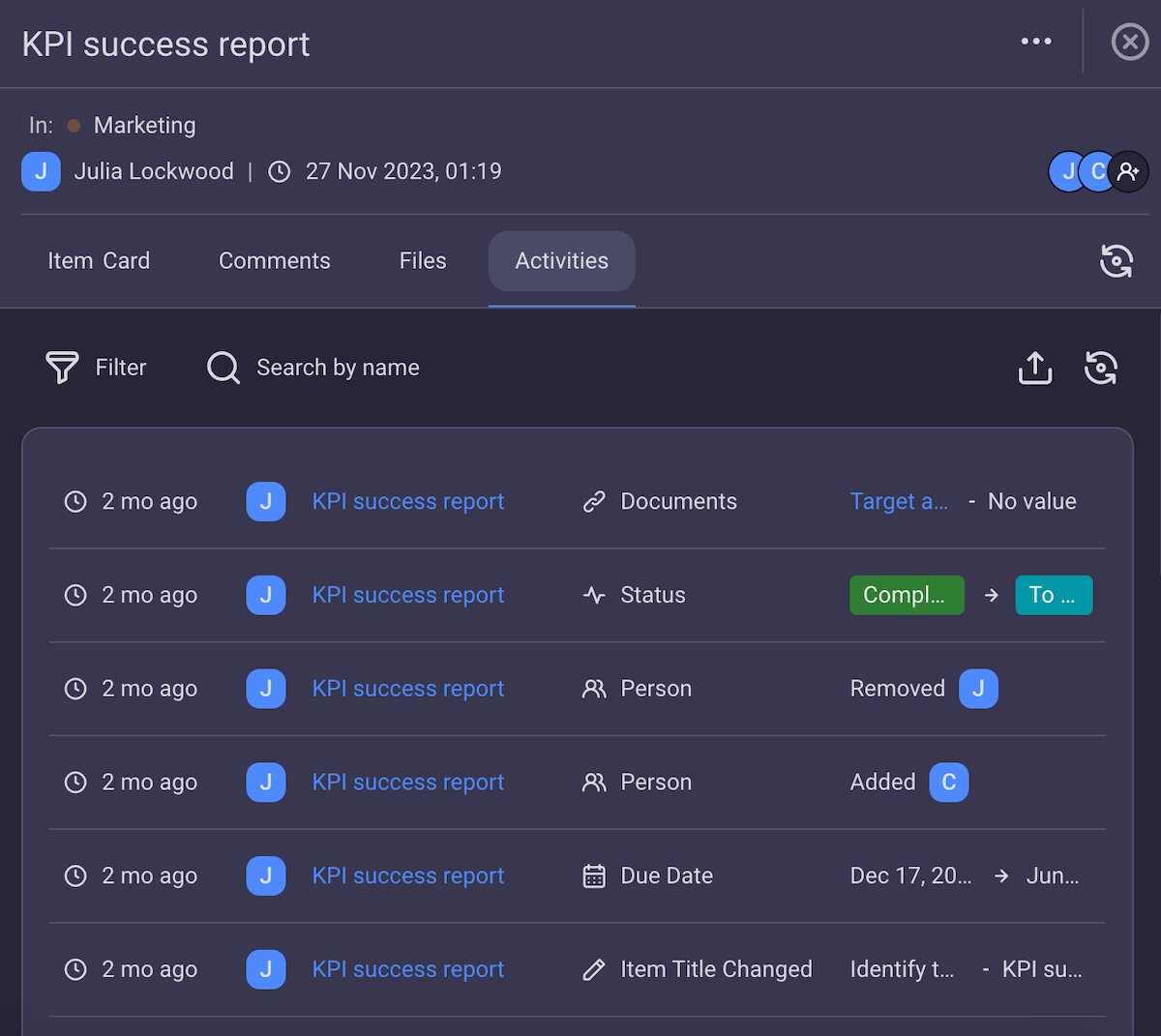
And since resources are a huge part of CCPM, you can also use Plaky to share files and documents necessary for completing certain tasks. As resource buffers serve as alerts, you can add them before different activities to remind yourself to add key files and docs to the task card before the activity commences.
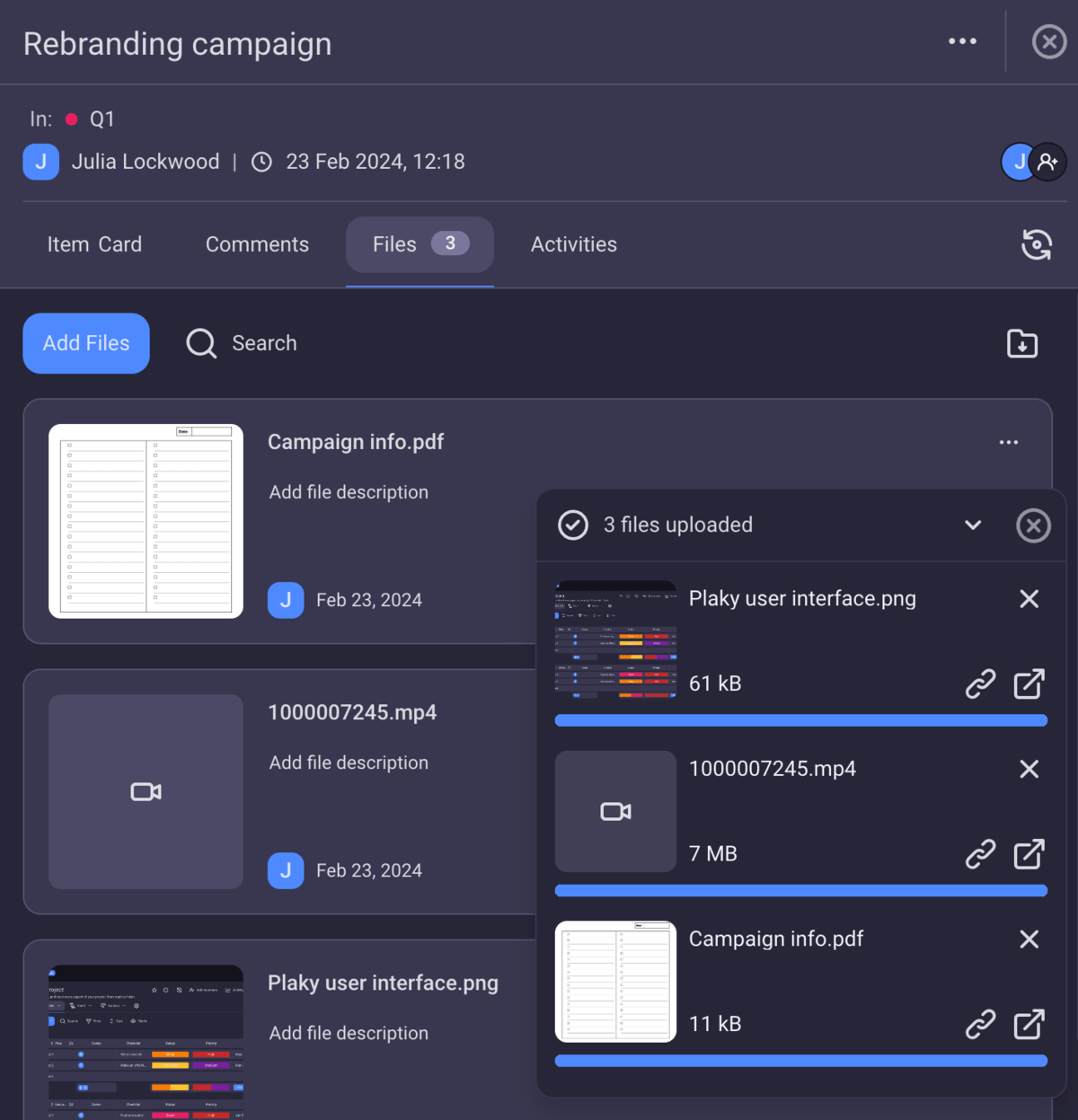
4 Critical chain project management advantages
The main advantages of using critical chain project management are that it:
- Improves project performance,
- Features built-in risk management,
- Ensures optimal resource allocation and utilization, and
- Supports team collaboration and greater efficiency.
Advantage #1: CCPM improves project performance
In theory, the main advantage of CCPM is that it can improve performance by speeding up task completion.
In traditional project management, ticking the tasks off the project management checklist as soon as they are finished has no bearing on the project deadline.
If tasks A and B both take 10 days to complete, and task C is dependent on both, then faster completion of task A won’t result in task C starting any sooner.
However, in CCPM, if tasks A and B are allocated 10 days to complete, with 5 days of buffer time on top of this — and they’re both completed without burning through any buffer time — then task C can start 5 days early.
CCPM also helps improve project performance because it steers away from multitasking, planned procrastination (student syndrome), sandbagging, and Parkinson’s law. CCPM effectively prevents these types of human behaviors from having too much of an impact on the project’s progression.
The expert we spoke to, Jan Schiller, also believes improved project performance is a major benefit of CCPM:

“The primary advantage of CCPM is predictable projects and a hugely improved ability to meet or exceed expectations about project performance. CCPM, especially when performed at an enterprise level, provides a global view of a project’s impact on the organization’s resources (especially human resources), therefore supporting informed decision-making on how to best achieve an organization’s strategies and improve productivity.”
Advantage #2: CCPM features built-in risk management
CCPM is not a replacement for risk management, and it doesn’t account for all potential risks. However, it has some form of risk management baked into it, as all scheduling changes made by resource leveling are effectively risks you’ve avoided.
Furthermore, due to the inclusion of buffers, CCPM allows project managers extra time to deal with unknown risks. And they know exactly how much time they have to sort out problems as these contingencies are included in the original critical chain plan.
In general, CCPM deals with one of the riskiest parts of project management — schedule reliability. CCPM provides you with a more realistic schedule your project team can actually see through the end.
Of course, keep in mind you should still conduct proper risk management on any project. CCPM just aids these efforts a bit.
💡 Plaky Pro Tip
Learn more about risk in project management, its elements, and the types that exist in the following guide:
Advantage #3: CCPM ensures optimal resource allocation and utilization
Since CCPM mainly focuses on resources as the top constraint, the critical chain method allows for a more optimal resource allocation.
In CCPM, it’s all about knowing in advance when and which resources will be needed — and then ensuring the resources are available just in time for the activities to start.
Overall, CCPM lets project managers plan more accurately and forecast resource needs to avoid potential shortages in the future. Moreover, it allows PMs to allocate them optimally so that every task has enough resources to be completed successfully.
Advantage #4: CCPM supports team collaboration and greater efficiency
CCPM requires full-on commitment and understanding of the project team. If they’re able to provide that, there’s a chance team collaboration will improve overall.
Using the critical chain method entails including the whole team into the process. Transparency is an obvious advantage here, but more importantly, if the whole team participates — they’re more aligned with the project goals. Though individuals will work on separate tasks, it’s the team effort that counts in CCPM.
Working together on creating the critical chain system also means the team will gain a better understanding of the project. In turn, this may help them perform the activities more successfully as they’ll know how exactly they contribute toward the project goals.
CCPM also allows the project manager to focus better on the critical tasks at hand. In turn, this can affect the team’s efficiency too.
The project manager doesn’t have to micromanage to ensure all the tasks are done on time — that’s the team’s job. Instead, they can focus on proper buffer allocation so that even if there’s any risk, they can successfully handle it on time.
Finally, keep in mind that in CCPM, time isn’t wasted on waiting for the next activity to start. Instead, it’s possible to start the next one as soon as you finish the previous one. This results in a higher level of efficiency — and a better chance of delivering the project on time.
💡 Plaky Pro Tip
Project collaboration is effectively a synonym for team collaboration and involves the whole project team working together toward a common goal. Read the guide below to check whether your project collaboration needs improvement — and how to make it better to ensure project success:
7 Critical chain project management disadvantages
For all its advantages, though, CCPM is rife with disadvantages. The major drawbacks of CCPM are that it:
- Can breed hostility among team members,
- Might encourage inflated estimates,
- Is not as foolproof as it seems,
- Steps away from traditional progress tracking,
- Is complex to implement and largely inflexible,
- Requires training, and
- Lacks studies that support its promises.
Disadvantage #1: CCPM can breed hostility among team members
CCPM works under the assumption employees either lie about how long it takes them to complete tasks or are inept to make realistic predictions.
If an employee estimates a task will take 10 days to complete, the project manager will only put 5 days on the project schedule. Though the buffer is also inserted to act as safety in this case, the buffer applies to a task sequence, not individual tasks.
You can see how this whole exchange can breed hostility and bitterness within the team. And, the more honest and accurate employees are in their task duration predictions, the worse CCPM gets.
Another problematic feature of CCPM that can breed hostility are resource buffers. In theory, they’re a great way to remind team members to prepare for upcoming activities. But as authors Tzvi Raz, Robert Barnes, and Dov Dvir conclude in their paper A Critical Look at Critical Chain Project Management, the coordination that the buffers aim to improve can become quite chaotic as people scramble to tie off any loose ends.
Additionally, the same paper mentions that project performance depends less on the PM’s skill for managing the schedule constraints and more on their interpersonal and leadership skills.
But CCPM, by its very nature, sabotages the good relations between PMs and team members required for interpersonal and leadership skills to shine.
This isn’t to say scheduling skills aren’t important. However, they shouldn’t come at the expense of soft skills that also contribute to project performance.
💡 Plaky Pro Tip
To do their job properly, PMs are required to excel at many soft and hard skills. You can find the complete list of project management skills in this guide:
Disadvantage #2: CCPM might encourage inflated estimates
Another problem with critical chain estimations is that not everyone estimates in the same way, or rather, in the same amount. According to the same paper mentioned above, estimates can vary among employees depending on their personality, workload, etc.
If the employees also know that the safety margin will be deducted and added to the buffer, they’re bound to keep adding larger ones to their tasks. That way, they can still enjoy the (real) safety margin and commit to the estimate without risking a potential delay.
Jan Schiller also mentioned how problematic resource buffering in CCPM could be when it’s not done well:

“The primary disadvantage of CCPM is that it encourages estimate padding (resource buffering in CCPM semantics) if not presented and applied in the appropriate context. Using resource buffering is a schedule risk mitigation action, and should be clearly communicated as such. Unless the resource buffer aligns with actual resource availability (in other words, if you need a resource to fill that buffer, the right resource is available to complete the work represented by the buffer), it is simply a way to make schedule variances harder to detect (and therefore, learn from).”
Disadvantage #3: CCPM isn’t as foolproof as it seems
The big thing about CCPM is that it involves planning ahead. You know there may be some roadblocks along the way, so you add time buffers. You know there are some activities that may require additional resources, so you make sure the resources are available at the right time.
But despite the use of buffers being quite intuitive, the methodology doesn’t instruct on their size — at least not by any scientific or objective criteria. Goldratt didn’t give too much thought to accuracy while originating the critical chain, and the proposed buffer sizing method certainly isn’t based on countless CCPM simulations.
Besides that, implementing any kinds of changes can be impractical with CCPM. It would require you to make new task estimates and ensure they don’t jeopardize the critical chain — which can be time-consuming and pretty wasteful in the grand scheme of things.
Disadvantage #4: CCPM steps away from traditional progress tracking
It’s not just the team members that need to get on board with radical changes required for CCPM project management. Executives also have to get comfortable with the idea of not using dates and milestones in favor of buffer-based progress tracking.
Buffer expenditure causes CCPM schedules to constantly change. This means milestones and dates would constantly shift, causing the project to appear worse for wear even if the project buffer shows everything is fine.
The project manager knows this, but clients and executives aren’t necessarily people with intimate knowledge of CCPM. They may prefer the simple-to-understand and no-nonsense nature of dates and milestones over the amorphous nature of project buffer progress signaling.
Disadvantage #5: CCPM is complex to implement and largely inflexible
Given all the steps you have to take to implement CCPM, it’s easy to conclude it’s not for the faint of heart. Proper preparation is key with this methodology.
Inflexibility is also something to consider as CCPM doesn’t exactly take into account unexpected changes or delays. It seems the buffers used in this methodology are largely there to fight against human behavior issues that lead to projects being late.
The resource buffer, for instance, can be particularly troublesome if you’re using outside contractors. You cannot expect those contractors to drop everything and dedicate their time to your tasks when necessary. And even then, there can be unexpected changes that prevent them from following through on the critical chain plan.
When it comes to implementation, CCPM is often a better option for larger projects — smaller ones benefit more from other, simpler approaches, such as Kanban project management, or even Scrum. However, even in the case of a larger project, the inflexibility of CCPM can pose various issues and make it too complex to implement and see through to the end.
The above-mentioned paper also states CCPM can be used in multi-project environments — but the authors doubt its success in that situation.
In a multi-project environment, CCPM requires you to stagger projects around the drum, i.e., the constraining resource that sets the beat for all the projects.
But logically speaking, there can be several constraining resources across various projects — and all of them can influence the schedule. Consequently, there would be many conflicting schedules between those projects, making the environment even more chaotic.
Disadvantage #6: CCPM requires training
As it’s new and complex, CCPM requires you to invest in training your project team to use the methodology.
Everyone working on the projects has to adopt CCPM in its entirety, which could cost a lot of money and cause major disruptions to the organizational culture. There wouldn’t be multitasking anymore, due dates and milestones would be deemed obsolete, and you’d get task extensions from a pooled time buffer.
All that alone makes CCPM uncomfortable to use for anyone who’s set in their own ways. It’s not only the commitment that is required here but also the willingness to change the way you work.
Disadvantage #7: CCPM lacks studies that support its promises
Last but not least, there is a lack of case study data confirming the effectiveness of critical chain project management. Many papers deal with the theory behind CCPM rather than with empirical evidence or case studies.
Some positive case studies do exist, of course. One example is a study on the use of CCPM in the construction industry of Romania, which investigated its ability to keep a project on schedule and deemed it a “breath of fresh air” for the country’s construction companies.
Another study, which examined the integration of a procurement management process into CCPM in oil and gas projects, showed CCPM is a better option for handling project uncertainty and reducing project duration when compared to more traditional methods like CPM.
There is also a study on the use of CCPM in software development that looked into both the methodology’s application in the industry and the different debates found in CCPM literature.
However, such case studies are few and far between, especially if we narrow them down by industry. Therefore, while the advantages of CCPM check out in theory, we lack substantial data that details the effects it has in practice.
Conclusion: CCPM builds on CPM and requires serious commitment
Critical chain project management helps create a resource-oriented project plan that accounts for many of the things CPM doesn’t take into consideration.
If you stop right after leveling the resources, you can use it as a scheduling algorithm and still overcome some of the limitations of CPM. However, unlike CPM and PERT, CCPM is not merely a scheduling algorithm.
The moment you implement buffers, CCPM becomes a fully-fledged project management methodology that reduces team members’ task duration estimates for the chance to increase productivity and prevent delays.
All this is to say that CCPM is a methodology that can work well — but ultimately requires complete corporate and employee buy-in to function properly.
📖 Now that you have mastered the critical chain method, continue learning about project management and everything it encompasses by exploring our Project Management Glossary of Terms.
References:
- Goldratt, E. M. (1997). Critical Chain. North River Press. https://www.goodreads.com/book/show/848514.Critical_Chain
- The Economist Newspaper. (n.d.). Parkinson’s law. The Economist. Retrieved June 30, 2023 from https://www.economist.com/news/1955/11/19/parkinsons-law
- Watson, J. M., & Strayer, D. L. (2010). Supertaskers: Profiles in extraordinary multitasking ability. Psychonomic Bulletin Review, 17(4), 479–485. https://doi.org/10.3758/pbr.17.4.479 Retrieved June 30, 2023 from https://link.springer.com/article/10.3758/PBR.17.4.479
- Cleveland Clinic. (2022, October 11). The science is clear: Why multitasking doesn’t work. Cleveland Clinic. Retrieved June 30, 2023 from https://health.clevelandclinic.org/science-clear-multitasking-doesnt-work/
- Valikoniene, L. (2014). Resource buffers in critical chain project management (thesis). Faculty of Engineering and Physical Sciences, University of Manchester. Retrieved June 30, 2023 from https://pure.manchester.ac.uk/ws/portalfiles/portal/54566800/FULL_TEXT.PDF
- Leach, L. P. (2014). Critical Chain Project Management. Artech House. https://www.goodreads.com/book/show/1105347.Critical_Chain_Project_Management
- Globerson, S. (2000). PMBOK and the critical chain. PM Network, 14(5), 63–66. Retrieved June 30, 2023 from https://www.researchgate.net/publication/291178133_PMBOK_and_the_critical_chain
- Ravalji, Jaydeepsinh & Deshpande, Vivek. (2014). Comparative study of alternatives for 50% rule in critical chain project management. International Conference on Design, Manufacturing and Mechatronics. Retrieved June 30, 2023 from https://www.researchgate.net/publication/296455536_Comparative_Study_of_Alternatives_for_50_Rule_in_Critical_Chain_Project_Management
- Raz, T., Barnes, R., & Dvir, D. (2004). A critical look at critical chain project management. IEEE Engineering Management Review, 32(2), 35–35. https://doi.org/10.1109/emr.2004.25048 Retrieved June 30, 2023 from https://www.researchgate.net/publication/3228307_A_Critical_Look_at_Critical_Chain_Project_Management
- Vrîncuţ, M. (2009). Critical chain management and the construction industry in Romania. Review of International Comparative Management , 10(5), 1060–1067. Retrieved June 30, 2023 from https://core.ac.uk/download/pdf/6819119.pdf
- Jo, S.-H., Lee, E.-B., & Pyo, K.-Y. (2018). Integrating a procurement management process into critical chain project management (CCPM): A case-study on oil and gas projects, the piping process. Sustainability, 10(6), 1817. https://doi.org/10.3390/su10061817 Retrieved June 30, 2023 from https://core.ac.uk/download/160190376.pdf
- Mirzaei, M., & Mabin, V. J. (2019). Critical chain project management: A case study in software industry. International Journal of Management and Applied Science, 5(3). Retrieved June 30, 2023 from https://www.semanticscholar.org/paper/Critical-Chain-project-management-%3A-a-case-study-in-Mirzaei-Mabin/33d589b19ae5e3a500775673b1faa90f96066eb7
- Online PM Courses – Mike Clayton. (2019). What is resource levelling? And how does it differ from resource smoothing? YouTube. Retrieved July 6, 2023, from https://www.youtube.com/watch?v=IvN6kyMUe3Q
 Project Management Hub
Project Management Hub 






